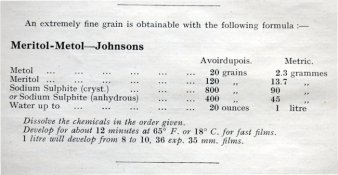Jerevan
Member
I was looking in a photographic book today, and found some chemistry recipes, one of which included Meritol. The book was reprinted in 1947, just to give a clue to its age.
I did a google on that name and came up with hexahydric alcohol, chemical name C6H14O6 and CAS 50-70-4. It seems more commonly known as Sorbitol.
Could it be this (sounds strange) or was Meritol a proprietary chemical substance?
I did a google on that name and came up with hexahydric alcohol, chemical name C6H14O6 and CAS 50-70-4. It seems more commonly known as Sorbitol.
Could it be this (sounds strange) or was Meritol a proprietary chemical substance?













